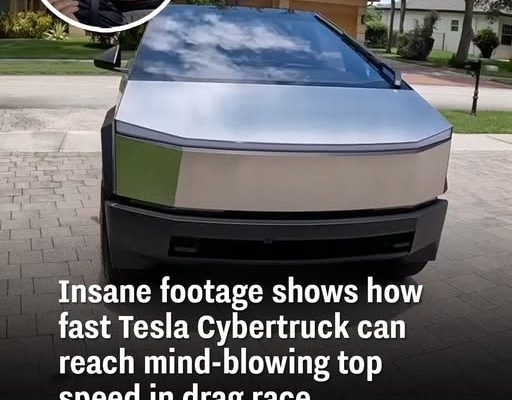
The Cybertruck might be famous for its rugged design and steel exterior, but it earned some credit for its track speed too.
Known for dominating tug-of-war showdowns against heavyweights like turbocharged Dodge Rams and even military Humvees, the Cybertruck has proven itself a force to be reckoned with.
Now, the Cybertruck is proving it’s not just about power, it’s packing speed too.
Thanks to the YouTube team DragTimes, we’re able to witness the truck hit an impressive top speed on the drag strip.
The specific model is the 600HP dual-motor foundation edition, which was brand-new – minus a few trips around the block in transportation. Despite its boxy and heavy-duty appearance, the Cybertruck left the mark without a ‘rollout’ and hit 60 mph in just four seconds.
But it doesn’t stop there.
DragTimes put the vehicle through a performance test and recorded just how quickly it could reach its top speed of 114mph.
The vehicle soon sped off into the distance, hitting its top speed and simultaneously crossing the quarter-mile time.
It took just 12:42 to reach the finish line and maxed out its speed less than a second later. The drag strip test video has already racked up nearly 130,000 views on YouTube, with viewers blown away by its performance.
“It gets up to top speed impressively quickly,” one user commented.
“I love how it goes so fas [sic],” added another.
Some fans are eager to see the DragTimes team try it out with a Tesla Cyberbeast.

Sjoerd van der Wal / Contributor / Getty
“Somebody give this man a Cyberbeast please,” someone else remarked. But if you thought the Cybertruck was fast, the Cyberbeast takes it to another level. With a tri-motor system, the vehicle pumps out an incredible 845 horsepower, delivering 50% more acceleration g-force than the standard Cybertruck.
And, according to DuPont Registry, the Cyberbeast rockets from 0 to 60 mph in a blistering 2.6 seconds.
The range is where the Cybertruck lacks, however.
What’s interesting about the Cybertruck however is its lack of range.
In another video by DragRaces, the Tesla Cybertruck went head-to-head with some high-performance competition in Aguadilla, Puerto Rico, during the ‘Fast or Nothing’ half-mile race.
The lineup included two bright-yellow Lamborghinis – the Aventador S and the Revuelto – as well as Tesla’s Model X Plaid.
Whilst the Tesla Cybertruck stormed into an early lead as the Lamborghini Aventador struggled to shift smoothly into second gear, its lead in the race was short-lived.
The Cyberbeast plateaued at 130 mph, allowing the Lamborghini to speed past and take the win.
Featured Image Credit: Dragtimes/YouTube

You only have to look at Tesla’s Cybertruck to realize it’s a beast of the automotive world.
Although the Cybertruck got an impressive price cut toward the end of 2024 due to slumping sales, the fact you’re paying $80,000 for the base all-wheel-drive model means it’s not exactly a cheap runaround.
Still, if your Cybertruck could double up as a car and a home, you can kill two birds with one stone.
We already covered the Cybertruck owner who hammered his vehicle and lived in it while he drove it 500,000 miles and even journeyed the Arctic Ocean.
While it looked fine as a temporary solution to provide shelter, it doesn’t exactly seem like a long-term solution to standard accommodation.
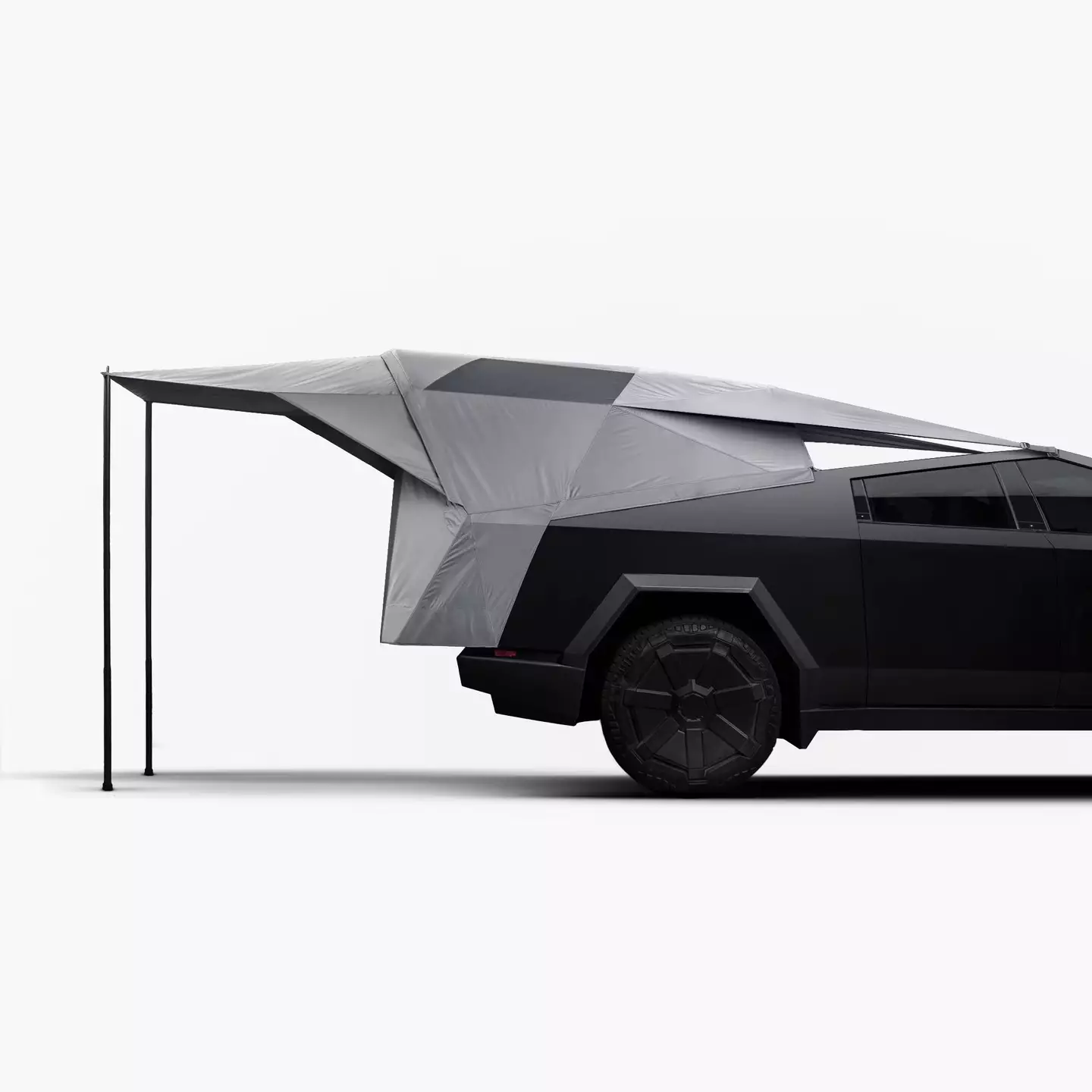
The Cybertruck already has its own official camp mode from Tesla (Tesla)
Now, YouTuber PeterMC put the Cybertruck through its paces and attempted to show whether you can comfortably live in one for 24 hours.
As he notes, the Cybertruck is electric AND has its camp mode, meaning it’s already got plenty of features that bring it closer to being a mobile home than your typical car.
PeterMC famously lived in his Tesla Model 3 for seven days, so this one should be a piece of cake.
He noted that the bed of the Cybertruck is bigger than some trucks, while there are three power outlets for you to plug in all your must-have appliances.
Although most of you wouldn’t try this, the first thing PeterMc did was throw a tarp down in the trunk and turn it into a mini pool for bathing in.
Obviously, we wouldn’t recommend filling an electric car with water.
On a more serious note, he said he loves the ‘Cyberpunk’ of the Cybertruck and hopes to own one of his own one day instead of renting one for a YouTube video.
Getting into the actual testing, he plugged in the Cybertruck because it was low on charge, attached a space heater, and then hunkered down for the evening.
Cooking burgers and rolling out a mattress in the trunk, he put on his heater and managed to get a good night’s sleep – albeit setting off the car’s alarm when he exited the bed.
In the end, PeterMC concluded that you probably could live in a Cybertruck, although we’d do it a little more conventionally than him.
Responding to the video, someone else said: “Stealth camping in the bed of the truck is crazy 😂 looks like you had fun with this one tho.”
While an entertaining video, not everyone was convinced. Someone else concluded:
“Theoretically the best car to live in? Like… why? It literally has one of the lowest space to size ratios of any car. Any old delivery van clears a Cybertruck in usable living space on top of being square, which is kind of a good shape to be if you’re trying to build a mini house.”
Of course, he didn’t use it in the typical camp mode that Tesla intends owners to use when roughing it in the wilderness. Shush, don’t tell Elon Musk.
Featured Image Credit: PeterMc / YouTube

Getting stranded in the cold with an electric vehicle is something that many prospective buyers are right to be concerned about, but one YouTuber shows that your Tesla might just fare better than expected.
Freezing temperatures are never nice to be outside in, and heating your car enough to combat the cold is something that can leave you in trouble if you end up stranded and unable to get home.
While most people won’t get close to the difficulty that Siberian residents have when it comes to driving in winter, you’ll still have to consider how far your vehicle can stretch if you do happen to get stuck on the road when its minus temperatures outside.
Thankfully YouTuber FrozenTesla has dispelled some myths surrounding electric vehicles, as they conducted an experience where their Tesla was left running all night while in temperatures of up to -28⁰C.
It’s meant to simulate what it would be like if there was a traffic jam or a landslide that stopped your car in its tracks, where you’ll want to turn on the heating, enable heated seats, and maybe even watch a movie while you wait for everything to clear.
Starting at 67% – as you’re never going to find yourself in a situation like this with a full battery – Keep Climate mode is activated to ensure that you stay nice and toasty in your car.
Checking back in every hour or so, the battery only drops around 3.5% every time despite these supposedly power-hungry features being enabled, and there’s even enough room for you to keep yourself entertained with a film or the radio too.
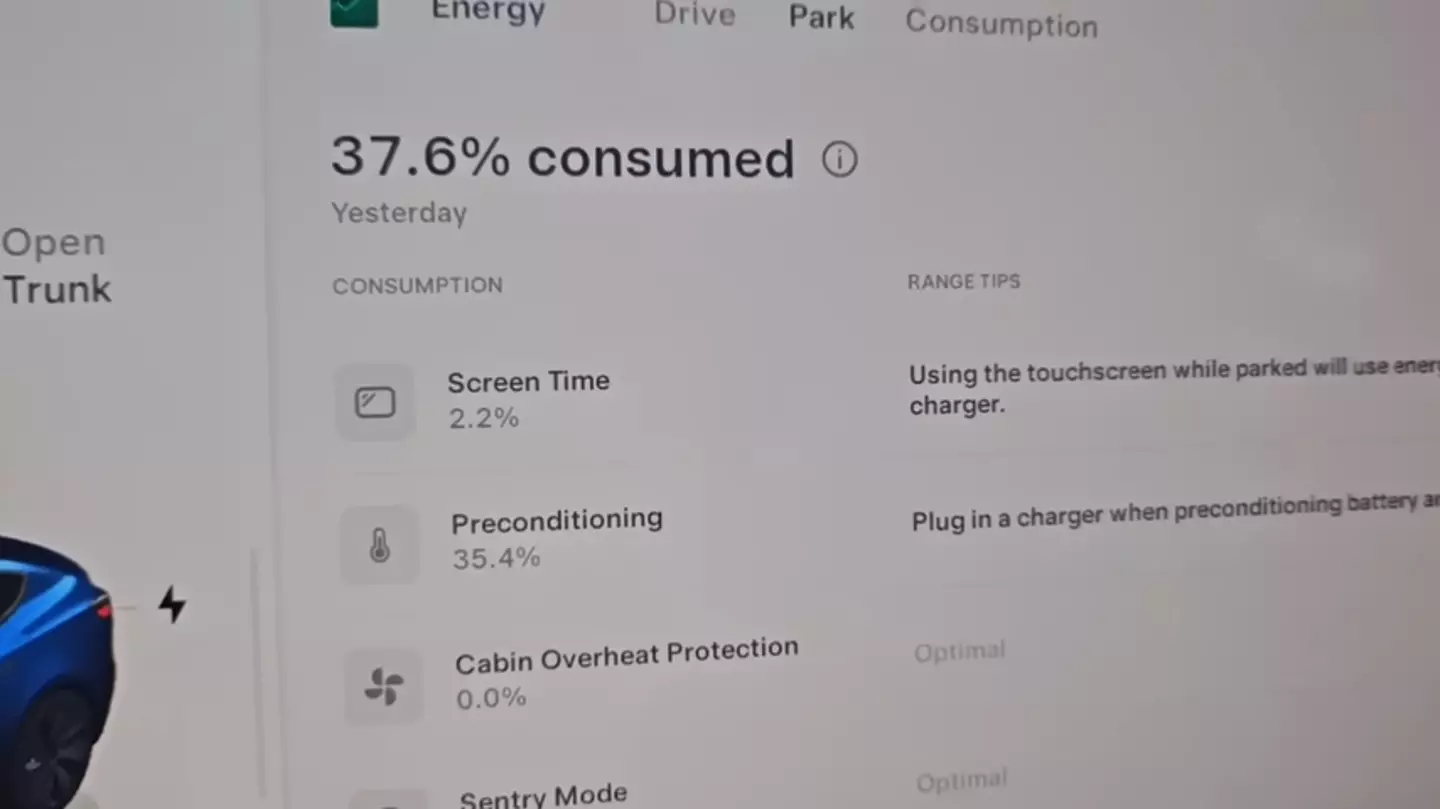
The Tesla consumed around 3% per hour when running idle overnight (YouTube/FrozenTesla)
Returning in the morning after around 12 hours or so, it’s shown that the battery has dropped to 29%, which is nearly 40% overall or just over 3% per hour. This would then give you a decent buffer to drive home with if you happened to be stuck for that length of time, but any less and you might have to start to worry.
Fully charged batteries would be able to be left on for around 31 hours though, which is definitely long enough to keep you going in the most extreme circumstances – although you do have to consider that the Model 3 in this video is the Long Range version which has a slightly larger battery capacity than it’s Rear-Wheel Drive counterpart.
Another thing to think about is that the equivalent cost in battery power for this length of time is around $3.58, whereas the same in standard gasoline cars would be around $7.86. This is, of course, double the price – but a small cost compared to that of getting your car towed.
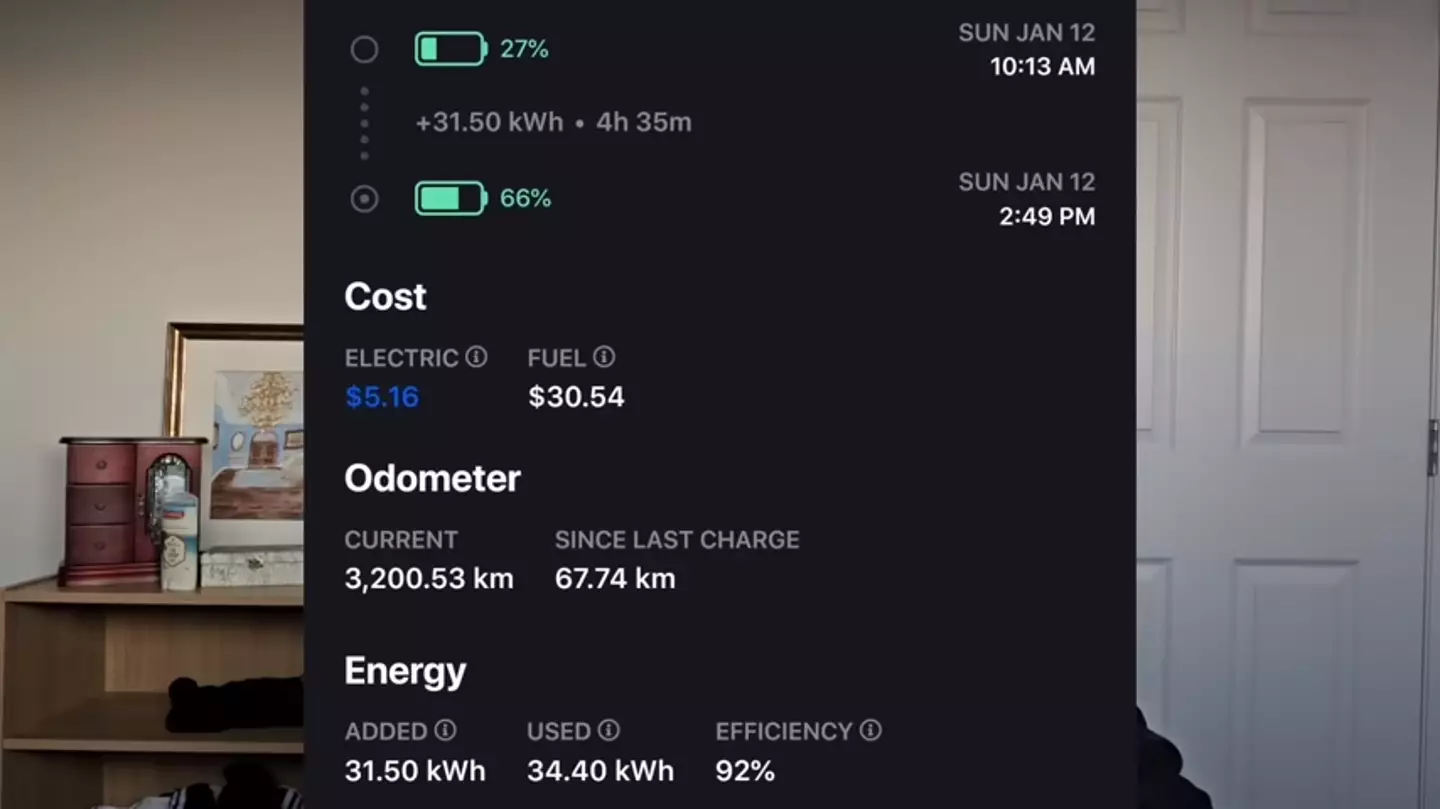
It’s cheaper than you’d think to leave your car’s heating running – something to consider on those colder days! (YouTube/FrozenTesla)
It’s true that you’re going to get a far longer idle time in a standard gas car compared to an EV, but it’s far less dramatic of a difference than you might expect, and the Tesla holds up more than enough to cope in extreme situations.
One comment remarks: “He just proved that having a Tesla in cold weather isn’t as dramatic as some people claim,” whereas another adds that “living in the arctic I can confirm that my Tesla is the best winter vehicle I’ve had.”
It’s definitely something to think about if cold climates are putting you off an EV, as it could be much more viable than you might think.
Featured Image Credit: FrozenTesla/YouTube

One short YouTube video has started a debate on social media, as the clip shows a Tesla Cybertruck driving through a red light while in Full Self-Driving (FSD) mode.
Tesla’s Cybertruck hasn’t exactly got the best reputation right now – even among existing fans of the electric car company – after numerous negative reviews and bizarre bad press.
While self-driving technology has been allegedly proven to be safer than human-operated vehicles in almost every metric, some horror stories still emerge that make you wonder whether the feature is truly ready to hit the road.
One new YouTube video from EV-enthusiast ‘Detroit Tesla’ has sparked that conversation up again, after they show their Cybertruck seemingly drive through a red light of its own accord – and the comments can’t quite settle on whether the car was right or wrong to do this.
The start of the video shows the vehicle approaching an intersection as the traffic lights are turning orange a good two or three seconds prior, going red mere moments after they pass the stop line.
Red lights are up for almost the entire time the car is turning, making people wonder whether this technically counts as the car running a red light without any user inputs.
This would certainly be a problem for FSD tech as you’d think that being able to identify a red light would be one of the first things that any self-driving car would need to do – and it could also endanger the driver both from a safety perspective and in regards to the law.
In fact, the driver mentions shortly after that it’s already tough for them to avoid attention as the notion of a Cybertruck alone paired with the 360⁰ camera installed on the car’s roof make it so that many eyes are always trained on the vehicle.
Running a red light in an instance like this would be like begging for a ticket or worse, so it’s definitely something you’d want to avoid.
The comments underneath remain split on whether this actually counts as running a red light though, as one user argues: “Nope not running. Was basically halfway into intersection. Did it seem like a need for a critical intervention to you? No.”
Another adds that there was “plenty of time to stop, but equally Cybertruck had entered the intersection by the time it changed so didn’t run the light (shrug emoji).”
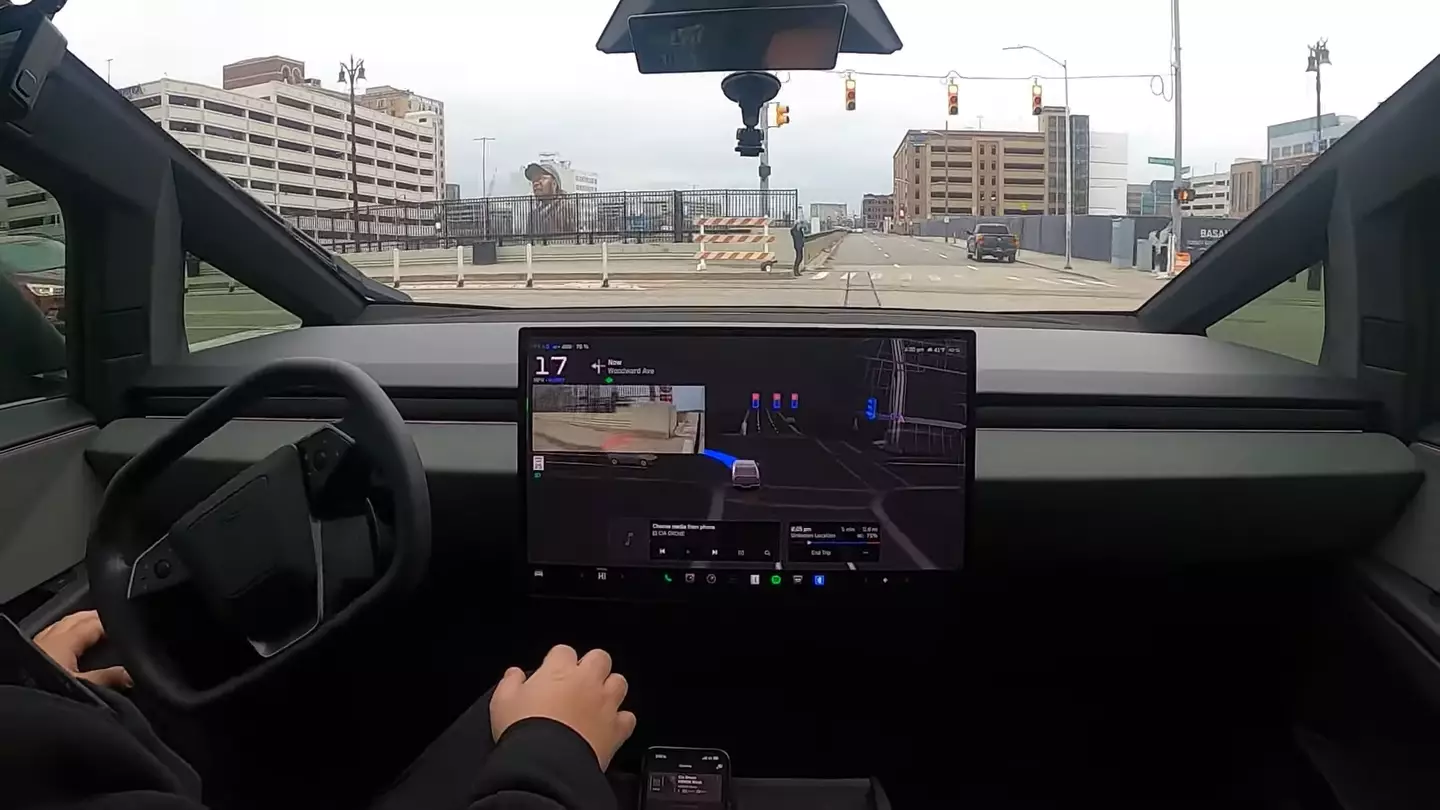
The traffic light went red just as the car started turning left (YouTube/Detroit Tesla)
One user does err on the side of caution though, advising: “There was plenty of time to stop for a red light, especially with the speed approaching the intersection. But I also thought it was OK to enter an intersection on a yellow… so 50/50. I would prefer the first scenario.”
This probably nails the situation on the head – while technically what the Cybertruck did was legal, and many drivers might do the same thing, the best course of action – especially for an FSD car – would be for it to be more cautious and stop before the red light appeared.
Featured Image Credit: YouTube/Detroit Tesla / SERGIO FLORES/Contributor / Getty

One YouTuber has detailed how owning his Cybertruck has actually saved him thousands every year compared to a ‘standard’ pickup truck, and the results are hard to ignore.
Tesla’s Cybertruck hasn’t exactly had the best reception following it’s 2023 release, receiving a number of negative reviews that point out ‘terrifying’ features that many consider to be dangerous.
Some have even ditched their Tesla trucks for old petrol cars due to the effects of colder weather, but the unique vehicle still has legions of fans behind its back – including one YouTuber who outlines quite an intriguing proposition.
After reaching the 10,000 mile mark with his Cybertruck, Devon Loerop has outlined exactly how much the process cost him across the course of a year – comparing it specifically to internal combustion engine (ICE) equivalents like the Ford F-150 Raptor.
Surprisingly, the Cybertruck not only comes out on top when it comes to cost both in the short and long-term, but it’s not even a competition!
Based on a case study of around 30,000 miles per year, Loerop estimates that the energy costs of the Cybertruck would total around $1,476 – working on the notion of around 100 charges at $0.12 per Kwh, which is the average price in his native state of Washington.
This cost would increase by quite a bit if you were to only charge on the road at superchargers, but for most Tesla drivers charging exclusively at home is a more viable circumstance.
You can even get it cheaper too, as Loerop himself only pays around $600 per year due to the lower cost at his apartment block, and some staggering stories have managed to get the cost down to mere single digits too.
The F-150 Raptor doesn’t come out nearly as favorably either, as the estimated 1,875 gallons of fuel needed at $4.50/gallon would set you back a staggering $8,424 for the year, and you’d also have to add on $450 for three oil changes.
He explains that one of the biggest benefits of Tesla cars is that they rarely (if ever) require servicing, whereas their ICE-equivalents need yearly oil changes and other adjustments. The flip side is that if your Tesla ever needed repairs then you’re going to pay a far higher cost – especially as you can rarely repair it yourself.
This is something that many second-hand Tesla buyers have found out too, as it can actually end up being cheaper to buy new due to the number of repairs that you can find in an older car.
You will end up paying around $1,000 more per-year with the Cybertruck compared to an F-150 Rapor, but the real killer blow is found when you see the ten-year cost estimate.
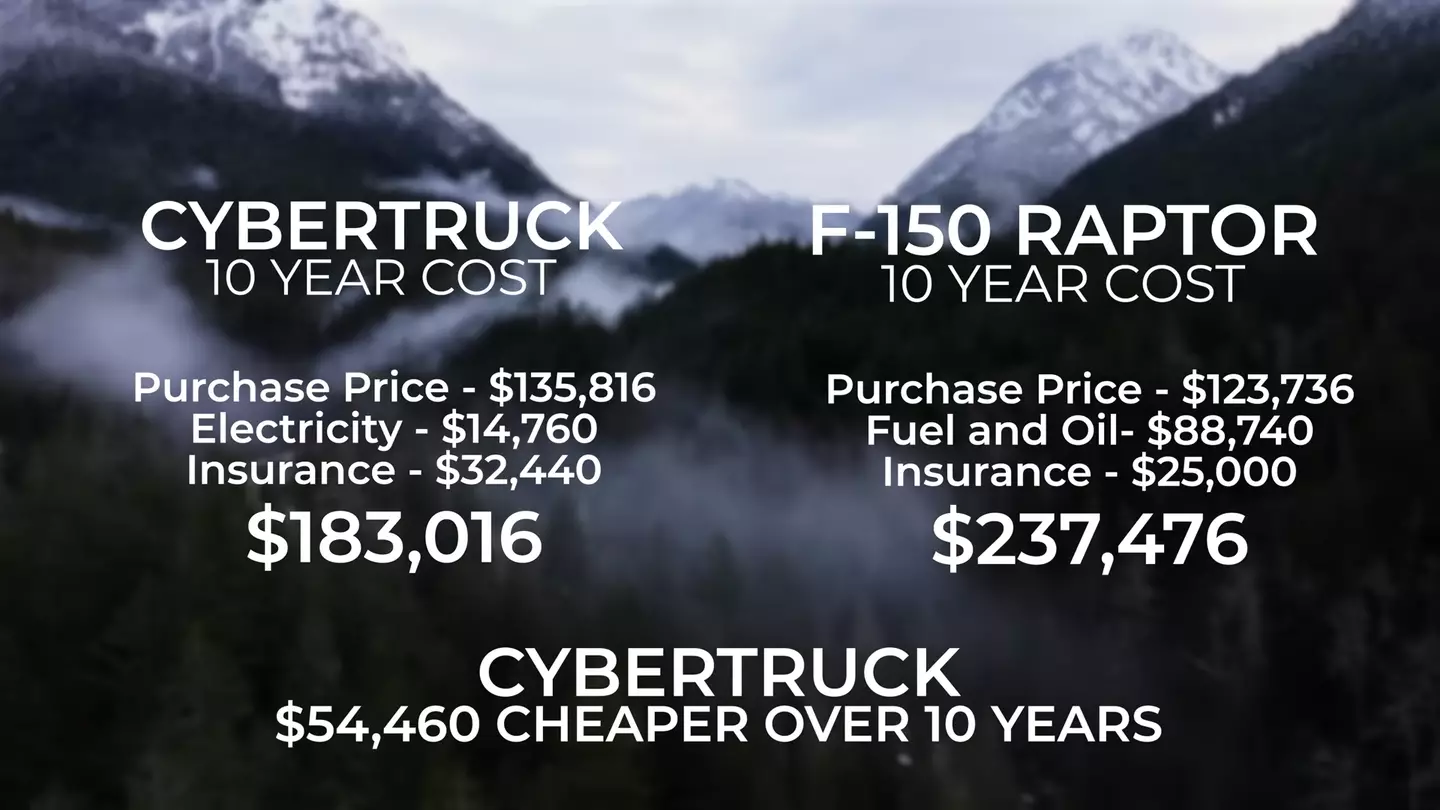
The decade-long cost for a Cybertruck is significantly lower than an F-150 Raptor (YouTube/Devon Loerop)
Accounting for the purchase price, electricity, and insurance, you’ll end up paying around $183,016 across ten years for the Cybertruck. This decade-long investment is increased by over $50,000 when jumping over to an F-150 Raptor, as that’ll set you back $237,476.
It goes to show that the Cybertruck might have the edge across a decade if you’re looking at things from a purely monetary perspective, so it’s definitely something to consider if you’re looking to pick up your next pickup for the long haul.
